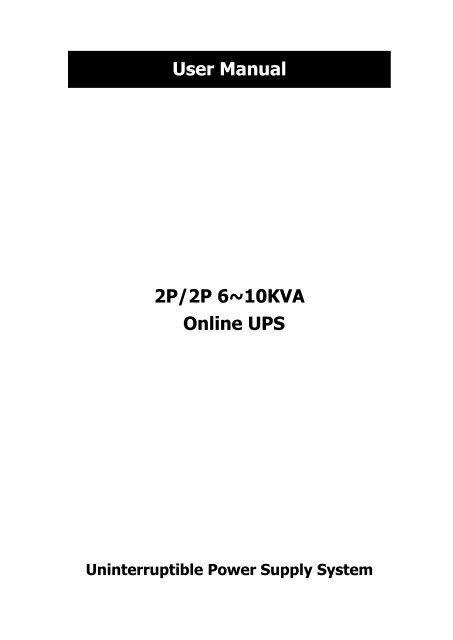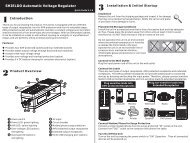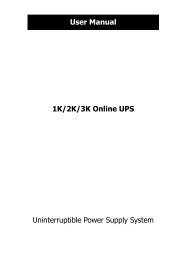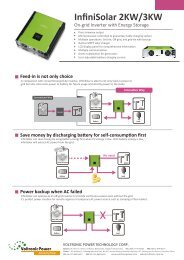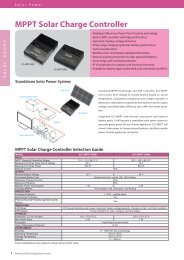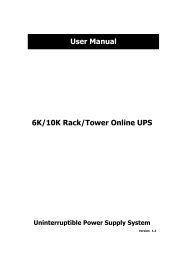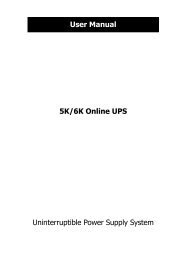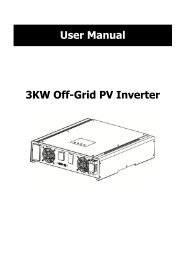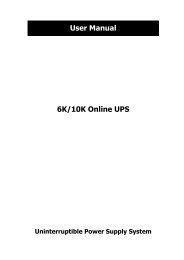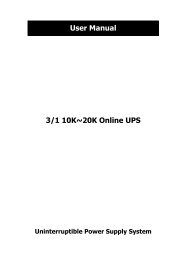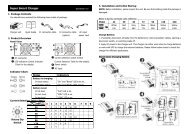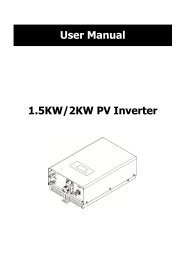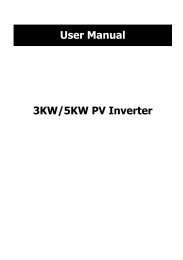2P/2P 6~10KVA Online UPS User Manual - Voltron
2P/2P 6~10KVA Online UPS User Manual - Voltron
2P/2P 6~10KVA Online UPS User Manual - Voltron
Create successful ePaper yourself
Turn your PDF publications into a flip-book with our unique Google optimized e-Paper software.
Please comply with all warnings and operatinginstructions in this manual strictly. Save thismanual properly and read carefully the followinginstructions before installing the unit. Do notoperate this unit before reading through allsafety information and operating instructionscarefully.0
Table of Contents1. SAFETY AND EMC INSTRUCTIONS ................................................................................................. 11-1. TRANSPORTATION AND STORAGE ............................................................................................................... 11-2. PREPARATION ....................................................................................................................................... 11-3. INSTALLATION ...................................................................................................................................... 11-4. OPERATION ......................................................................................................................................... 21-5. STANDARDS ......................................................................................................................................... 22. INSTALLATION AND OPERATION .................................................................................................. 32-1. UNPACKING AND INSPECTION ................................................................................................................... 32-2. REAR PANEL VIEW................................................................................................................................. 32-3. SINGLE <strong>UPS</strong> INSTALLATION ..................................................................................................................... 52-4. SOFTWARE INSTALLATION ....................................................................................................................... 63. OPERATIONS .................................................................................................................................. 73-1. BUTTON OPERATION .............................................................................................................................. 73-2. LED INDICATORS AND LCD PANEL ............................................................................................................ 73-3. AUDIBLE ALARM.................................................................................................................................... 93-4. SINGLE <strong>UPS</strong> OPERATION ........................................................................................................................ 93-5. ABBREVIATION MEANING IN LCD DISPLAY ................................................................................................. 123-6. LCD SETTING .................................................................................................................................... 133-7. OPERATING MODE/STATUS DESCRIPTION ................................................................................................. 193-8. FAULT CODE ...................................................................................................................................... 223-9. WARNING INDICATOR .......................................................................................................................... 233-10.WARNING CODE ................................................................................................................................ 234. TROUBLE SHOOTING ................................................................................................................... 245. STORAGE AND MAINTENANCE ..................................................................................................... 265-1. STORAGE .......................................................................................................................................... 265-2. MAINTENANCE .................................................................................................................................... 266. SPECIFICATIONS ......................................................................................................................... 270
1. Safety and EMC instructionsPlease read carefully the following user manual and the safety instructions before installing the unit or usingthe unit!1-1. Transportation and StoragePlease transport the <strong>UPS</strong> system only in the original package to protect against shock andimpact.1-2. PreparationThe <strong>UPS</strong> must be stored in the room where it is ventilated and dry.Condensation may occur if the <strong>UPS</strong> system is moved directly from cold to warm environment.The <strong>UPS</strong> system must be absolutely dry before being installed. Please allow at least two hours for the<strong>UPS</strong> system to acclimate the environment.1-3. InstallationDo not install the <strong>UPS</strong> system near water or in moist environments.Do not install the <strong>UPS</strong> system where it would be exposed to direct sunlight or nearby heater.Do not block ventilation holes in the <strong>UPS</strong> housing.Do not connect appliances or devices which would overload the <strong>UPS</strong> (e.g. big motor-typeequipment)) to the <strong>UPS</strong> output sockets or terminal.Place cables in such a way that no one can step on or trip over them.Do not block air vents in the housing of <strong>UPS</strong>. The <strong>UPS</strong> must be installed in a location with goodventilation. Ensure enough space on each side for ventilation.<strong>UPS</strong> has provided earthed terminal, in the final installed system configuration, equipotentialearth bonding to the external <strong>UPS</strong> battery cabinets.The <strong>UPS</strong> can be installed only by qualified maintenance personnel.An appropriate disconnect device as short-circuit backup protection should be provided in thebuilding wiring installation.An integral single emergency switching device which prevents further supply to the load by the<strong>UPS</strong> in any mode of operation should be provided in the building wiring installation.Connect the earth before connecting to the building wiring terminal.Installation and Wiring must be performed in accordance with the local electrical laws andregulations.1
1-4. OperationDo not disconnect the earth conductor cable on the <strong>UPS</strong> or the building wiring terminals in anytime since this would cancel the protective earth of the <strong>UPS</strong> system and of all connected loads.The <strong>UPS</strong> system features its own, internal current source (batteries). The <strong>UPS</strong> output sockets oroutput terminal blocks may be electrically live even if the <strong>UPS</strong> system is not connected to the buildingwiring outlet.In order to fully disconnect the <strong>UPS</strong> system, first press the “OFF” button and then disconnect themains.1-5. StandardsEnsure that no liquid or other foreign objects can enter into the <strong>UPS</strong> system.The <strong>UPS</strong> can be operated by any individuals with no previous experience.* EMIFCC Part 15, Subpart B,* Surge immunityIEEE/ANSI C62.41* TransportationISTA Procedure 1AClass ACategory A & BWarning: This is a product for commercial and industrial application in the secondenvironment-installation restrictions or additional measures may be needed to preventdisturbances.2
Diagram 3 : 10K Input/Output Terminal Diagram 4 : 10KL Input/Output TerminalDiagram 5 : 6K/6KL Rear PanelDiagram 6 :6K(L) Input/OutputTerminal1. RS-232 communication port2. USB communication port3. Emergency power off function connector (EPO connector)4. Share current port (only reserved for parallel model)5. Parallel port (only reserved for parallel model)6. Intelligent slot7. Power stage fan8. Charger fan9. Maintenance bypass switch4
10. Input circuit breaker11. Input/Output terminal (Refer to Diagram 4 and 6 for the details)12. Grounding terminal13. Output terminal14. External battery terminal (only available for Long-run model)15. Utility input terminal2-3. Single <strong>UPS</strong> InstallationInstallation and wiring must be performed in accordance with the local electric laws/regulations and executethe following instructions by professional personnel.1) Make sure the mains wire and breakers in the building are enough for the rated capacity of <strong>UPS</strong> toavoid the hazards of electric shock or fire.NOTE: Do not use the wall receptacle as the input power source for the <strong>UPS</strong>, as its rated current is less thanthe <strong>UPS</strong>’s maximum input current. Otherwise the receptacle may be burned and destroyed.2) Switch off the mains switch in the building before installation.3) Turn off all the connected devices before connecting to the <strong>UPS</strong>.4) Prepare wires based on the following table:ModelWiring spec (AWG)Input Output Battery Ground6K 10 10 106KL 10 10 10 1010K 8 8 810KL 8 8 8 8NOTE 1: The cable for 6K/6KL should be able to withstand over 50A current. It is recommended touse 10AWG or thicker wire for safety and efficiency.NOTE 2: The cable for 10K/10KL should be able to withstand over 63A current. It is recommended touse 8AWG or thicker wire for safety and efficiency.NOTE 3: The selections for color of wires should be followed by the local electrical laws andregulations.5) Remove the terminal block cover on the rear panel of <strong>UPS</strong>. Then connect the wires according to thefollowing terminal block diagrams: (Connect the earth wire first when making wire connection. Disconnectthe earth wire last when making wire disconnection!)Terminal Block wiring diagram of 6K(L)/10K(L)NOTE 1: Make sure that the wires are connected tightly with the terminals.5
NOTE 2: Please install the output breaker between the output terminal and the load, and the breakershould be qualified with leakage current protective function if necessary.6) Put the terminal block cover back to the rear panel of the <strong>UPS</strong>.Warning: (Only for standard model)● Make sure the <strong>UPS</strong> is not turned on before installation. The <strong>UPS</strong> should not be turned on during wiringconnection.● Do not try to modify the standard model to the long-run model. Particularly, do not try to connect thestandard internal battery to the external battery. The battery type and voltage may be different. If youconnect them together, it maybe causes the hazard of electric shock or fire!Warning: (Only for long-run model)● Make sure a DC breaker or other protection device between <strong>UPS</strong> and external battery pack is installed. Ifnot, please install it carefully. Switch off the battery breaker before installation.NOTE: Set the battery pack breaker in “OFF” position and then install the battery pack.● Pay highly attention to the rated battery voltage marked on the rear panel. If you want to change thenumbers of the battery pack, please make sure you modify the setting simultaneously. The connectionwith wrong battery voltage may cause permanent damage of the <strong>UPS</strong>. Make sure the voltage of thebattery pack is correct.● Pay highly attention to the polarity marking on external battery terminal block, and make sure thecorrect battery polarity is connected. Wrong connection may cause permanent damage of the <strong>UPS</strong>.● Make sure the protective earth ground wiring is correct. The wire current spec, color, position,connection and conductance reliability should be checked carefully.● Make sure the utility input & output wiring is correct. The wire current spec, color, position, connectionand conductance reliability should be checked carefully. Make sure the L/N site is correct, not reverseand short-circuited.2-4. Software InstallationFor optimal computer system protection, install <strong>UPS</strong> monitoring software to fully configure <strong>UPS</strong> shutdown.6
3. Operations3-1. Button OperationButtonON/Enter ButtonOFF/ESC ButtonTest/Up ButtonMute/Down ButtonTest/Up +Mute/Down ButtonFunction‣ Turn on the <strong>UPS</strong>: Press and hold the button more than 0.5s to turn on the <strong>UPS</strong>.‣ Enter Key: Press this button to confirm the selection in setting menu.‣ Turn off the <strong>UPS</strong>: Press and hold the button more than 0.5s to turn off the <strong>UPS</strong>.‣ Esc key: Press this button to return to last menu in setting menu.‣ Battery test: Press and hold the button more than 0.5s to test the battery whilein AC mode or CVCF* mode.‣ UP key: Press this button to display next selection in setting menu.‣ Mute the alarm: Press and hold the button more than 0.5s to mute the buzzer.Please refer to section 3-4-9 for details.‣ Down key: Press this button to display previous selection in setting menu.‣ Press and hold the two buttons simultaneous more than 1s to enter/escape thesetting menu.* CVCF means Constant Voltage and Constant Frequency.3-2. LED Indicators and LCD PanelLCD panelLED Indicators:There are 4 LEDs on front panel to show the <strong>UPS</strong> working status:Mode LED Bypass Line Battery Fault<strong>UPS</strong> On ● ● ● ●No Output mode ○ ○ ○ ○Bypass mode ● ○ ○ ○AC mode ○ ● ○ ○Battery mode ○ ○ ● ○CVCF mode ○ ● ○ ○Battery Test ● ● ● ○ECO mode ● ● ○ ○Fault ○ ○ ○ ●Note: ● means LED is lighting, and ○ means LED is faded.LED indicators7
LCD Panel:DisplayBackup time informationFault informationFunctionIndicates the battery discharge time in numbers.H: hours, M: minutes, S: secondsIndicates that the warning and fault occurs.Indicates the fault codes, and the codes are listed in details in section 3-9.Mute operationIndicates that the <strong>UPS</strong> alarm is disabled.Output & Battery voltage informationIndicates the output voltage, frequency or battery voltage.Vac: output voltage, Vdc: battery voltage, Hz: frequencyLoad informationIndicates the load level by 0-25%, 26-50%, 51-75%, and 76-100%.Indicates overload.Indicates the load or the output is short.Mode operation informationIndicates the <strong>UPS</strong> connects to the mains.Indicates the battery is working.Indicates the bypass circuit is working.Indicates the ECO mode is enabled.Indicates the Inverter circuit is working.Indicates the output is working.Battery informationIndicates the Battery capacity by 0-25%, 26-50%, 51-75%, and 76-100%.8
Input & Battery voltage information3-3. Audible AlarmIndicates the battery is not connected.Indicates low battery level and low battery voltage.Indicates the input voltage or frequency or battery voltage.Vac: Input voltage, Vdc: battery voltage, Hz: input frequencyDescription Buzzer status Muted<strong>UPS</strong> statusBypass modeBeeping once every 2 minutesBattery modeBeeping once every 4 seconds YesFault modeBeeping continuouslyWarningOverloadBeeping twice every secondOthersBeeping once every secondNoFaultAll Beeping continuously Yes3-4. Single <strong>UPS</strong> Operation1. Turn on the <strong>UPS</strong> with utility power supply (in AC mode)1) After power supply is connected correctly, set the breaker of the battery pack at “ON” position (thestep only available for long-run model). Then set the input breaker at “ON” position. At this timethe fan is running and the <strong>UPS</strong> enter to power on mode for initialization, several seconds later, <strong>UPS</strong>operates in Bypass mode and supplies power to the loads via the bypass.NOTE: When <strong>UPS</strong> is in Bypass mode, the output voltage will directly power from utility after youswitch on the input breaker. In Bypass mode, the load is not protected by <strong>UPS</strong>. To protect yourprecious devices, you should turn on the <strong>UPS</strong>. Refer to next step.2) Press and hold the “ON” button for 0.5s to turn on the <strong>UPS</strong> and the buzzer will beep once.3) A few seconds later, the <strong>UPS</strong> will enter to AC mode. If the utility power is abnormal, the <strong>UPS</strong> willoperate in Battery mode without interruption.NOTE: When the <strong>UPS</strong> is running out battery, it will shut down automatically at Battery mode. When theutility power is restored, the <strong>UPS</strong> will auto restart in AC mode.2. Turn on the <strong>UPS</strong> without utility power supply (in Battery mode)1) Make sure that the breaker of the battery pack is at “ON” position (only for long-run model).2) Press the “ON” button to set up the power supply for the <strong>UPS</strong>, <strong>UPS</strong> will enter to power on mode.After initialization <strong>UPS</strong> will enter to No Output mode, then Press and hold the “ON” button for 0.5sto turn on the <strong>UPS</strong>, and the buzzer will beep once.3) A few seconds later, the <strong>UPS</strong> will be turned on and enter to Battery mode.3. Connect devices to <strong>UPS</strong>After the <strong>UPS</strong> is turned on, you can connect devices to the <strong>UPS</strong>.1) Turn on the <strong>UPS</strong> first and then switch on the devices one by one, the LCD panel will display totalload level.2) If it is necessary to connect the inductive loads such as a printer, the in-rush current should becalculated carefully to see if it meets the capacity of the <strong>UPS</strong>, because the power consumption ofthis kind of loads is too big.3) If the <strong>UPS</strong> is overload, the buzzer will beep twice every second.4) When the <strong>UPS</strong> is overload, please remove some loads immediately. It is recommended to have thetotal loads connected to the <strong>UPS</strong> less than 80% of its nominal power capacity to prevent overload9
for system safety.5) If the overload time is over acceptable time listed in spec at AC mode, the <strong>UPS</strong> will automaticallytransfer to Bypass mode. After the overload is removed, it will return to AC mode. If the overloadtime is over acceptable time listed in spec at Battery mode, the <strong>UPS</strong> will become fault status. At thistime, if bypass is enabled, the <strong>UPS</strong> will power to the load via bypass. If bypass function is disabledor the input power is not within bypass acceptable range, it will cut off output directly.4. Charge the batteries1) After the <strong>UPS</strong> is connected to the utility power, the charger will charge the batteries automaticallyexcept in Battery mode or during battery self-test.2) Suggest to charge batteries at least 10 hours before use. Otherwise, the backup time may beshorter than expected time.3) Make sure the battery numbers setting on the control board (Please refer to the section 3-4-12 fordetailed setting) is consistent to real connection.5. Battery mode operation1) When the <strong>UPS</strong> is in Battery mode, the buzzer will beep according to different battery capacity. If thebattery capacity is more than 25%, the buzzer will beep once every 4 seconds; If the batteryvoltage drops to the alarm level, the buzzer will beep quickly (once every sec) to remind users thatthe battery is at low level and the <strong>UPS</strong> will shut down automatically soon. <strong>User</strong>s could switch offsome non-critical loads to disable the shutdown alarm and prolong the backup time. If there is nomore load to be switched off at that time, you have to shut down all loads as soon as possible toprotect the devices or save data. Otherwise, there is a risk of data loss or load failure.2) In Battery mode, if buzzer sound annoys, users can press the Mute button to disable the buzzer.3) The backup time of the long-run model depends on the external battery capacity.4) The backup time may vary from different environment temperature and load type.5) When setting backup time for 16.5 hours (default value from LCD panel), after discharging 16.5hours, <strong>UPS</strong> will shut down automatically to protect the battery. This battery discharge protectioncan be enabled or disabled through LCD panel control. (Refer to 3-6 LCD setting section)6. Test the batteries1) If you need to check the battery status when the <strong>UPS</strong> is running in AC mode/CVCF mode, you couldpress the “Test” button to let the <strong>UPS</strong> do battery self-test.2) <strong>User</strong>s also can set battery self-test through monitoring software.3) If the <strong>UPS</strong> is at battery self-test, the LCD display and buzzer indication will be the same as atBattery mode except that the battery LED is flashing.7. Turn off the <strong>UPS</strong> with utility power supply in AC mode1) Turn off the inverter of the <strong>UPS</strong> by pressing “OFF” button for at least 0.5s, and then the buzzer willbeep once. The <strong>UPS</strong> will turn into Bypass mode.NOTE 1: If the <strong>UPS</strong> has been set to enable the bypass output, it will bypass voltage from utilitypower to output terminal even though you have turned off the <strong>UPS</strong> (inverter).NOTE 2: After turning off the <strong>UPS</strong>, please be aware that the <strong>UPS</strong> is working at Bypass mode andthere is risk of power loss for connected devices.2) In Bypass mode, output voltage of the <strong>UPS</strong> is still present. In order to cut off the output, switch offthe input breaker. A few seconds later, there is no display shown on the display panel and <strong>UPS</strong> iscomplete off.10
8. Turn off the <strong>UPS</strong> without utility power supply in Battery mode1) Turn off the <strong>UPS</strong> by pressing “OFF” button for at least 0.5s, and then the buzzer will beep once.2) Then <strong>UPS</strong> will cut off power to output and there is no display shown on the display panel.9. Mute the buzzer1) To mute the buzzer, please press the “Mute” button for at least 0.5s. If you press it again after thebuzzer is muted, the buzzer will beep again.2) Some warning alarms can’t be muted unless the error is fixed. Please refer to section 3-3 for thedetails.10. Operation in warning status1) When Fault LED flashes and the buzzer beeps once every second, it means that there are someproblems for <strong>UPS</strong> operation. <strong>User</strong>s can get the warning indicator from LCD panel. Please check thetrouble shooting table in chapter 4 for details.2) Some warning alarms can’t be muted unless the error is fixed. Please refer to section 3-3 for thedetails.11. Operation in Fault mode1) When Fault LED illuminates and the buzzer beeps continuously, it means that there is a fatal error inthe <strong>UPS</strong>. <strong>User</strong>s can get the fault code from display panel. Please check the trouble shooting tablein chapter 4 for details.2) Please check the loads, wiring, ventilation, utility, battery and so on after the fault occurs. Don’t tryto turn on the <strong>UPS</strong> again before solving the problems. If the problems can’t be fixed, please contactthe distributor or service people immediately.3) For emergency case, please cut off the connection from utility, external battery, and outputimmediately to avoid more risk or danger.12. Operation of changing battery numbers1) This operation is only available for professional or qualified technicians.2) Turn off the <strong>UPS</strong>. If the load couldn’t be cut off, you should remove the cover of maintenancebypass switch on the rear panel and turn the maintenance switch to “BPS” position first.3) Switch off the input breaker, and switch off the battery breaker (only available for long-run model).4) Remove the cabinet cover, and disconnect battery wire for standard model. Then, modify thejumper of JS3 on the control board to set the battery numbers as following table.Battery Numberof each seriesJS3pin1 & pin2 pin3 & pin4 Pin5 & pin6 pin7 & pin89 0 1 X X10 1 0 X XNote:1 = insert with jumper; 0 = no jumper; x = these pins are for other functions.5) Change battery packs according to jumper setting carefully. After complete it, put the cover back,switch on the battery breaker for long-run model.6) Switch on the input breaker and the <strong>UPS</strong> will enter Bypass mode. If the <strong>UPS</strong> is in maintenanceBypass mode, turn the maintenance switch to “<strong>UPS</strong>” position and then turn on the <strong>UPS</strong>.11
3-5. Abbreviation Meaning in LCD DisplayAbbreviation Display content MeaningENAEnableDISDisableATOAutoBATBatteryNCFNormal mode (not CVCF mode)CFCVCF modeSUBSubtractADDAddONOnOFFOffFBDNot allowedOPNAllowRESReservedN.LNeutral lossCHECheckOP.VOutput voltageCPConstant phase angleOP.PTwo phase output parallel functionL1The first phaseL2The second phaseLLLine to line voltage12
3-6. LCD SettingThere are three parameters to set up the <strong>UPS</strong>. Refer to following diagram.Parameter 1Parameter 1: It’s for program alternatives. Referto below table for the programs to set up.Parameter 2 and parameter 3 are the settingoptions or values for each program.Note: Please select “Up” or “Down” button tochange the programs or parameters.Parameter 2 Parameter 3Programs available list for parameter 1:Code DescriptionBypassMode/NoOutput Mode01 Output voltage Y02 Output frequency Y03 Output phase angle Y04 Output phases (L1, L2) parallel Y05 Voltage range for bypass Y06 Frequency range for bypass Y07 ECO mode enable/disable Y08 Voltage range for ECO mode Y09 Frequency range for ECO mode YAC ECO CVCF Battery Batterymode mode mode mode Test10 Bypass mode setting Y Y11Battery maximum discharge timesettingY Y Y Y Y Y12 Neutral loss detection Y Y Y Y Y Y13 Battery voltage calibration Y Y Y Y Y Y14 Charger voltage adjustment Y Y Y Y Y Y15 Inverter1 voltage adjustment Y Y Y16 Inverter2 voltage adjustment Y Y Y*Y means that this program can be set in this mode.13
• 01: Output voltageInterface• 02: Output frequencyInterface60 Hz, CVCF mode50 Hz, Normal modeATO• 03: Output phase angleInterfaceSettingParameter 3: Output voltageYou may choose the following output voltage in parameter 3:100: Presents output voltage is 100Vac110: Presents output voltage is 110Vac115: Presents output voltage is 115Vac120: Presents output voltage is 120Vac127: Presents output voltage is 127VacSettingParameter 2: Output FrequencySetting the output frequency. You may choose following threeoptions in parameter 2:50.0Hz: The output frequency is setting for 50.0Hz.60.0Hz: The output frequency is setting for 60.0Hz.ATO: If selected, output frequency will be decided according tothe latest normal utility frequency. If it is from 46Hz to 54Hz, theoutput frequency will be 50.0Hz. If it is from 56Hz to 64Hz, theoutput frequency will be 60.0Hz. ATO is default setting.Parameter 3: Frequency modeSetting output frequency at CVCF mode or not CVCF mode. Youmay choose following two options in parameter 3:CF: Setting <strong>UPS</strong> to CVCF mode. If selected, the output frequencywill be fixed at 50Hz or 60Hz according to setting in parameter 2.The input frequency could be from 46Hz to 64Hz.NCF: Setting <strong>UPS</strong> to normal mode (not CVCF mode). If selected,the output frequency will synchronize with the input frequencywithin 46~54 Hz at 50Hz or within 56~64 Hz at 60Hz according tosetting in parameter 2. If 50 Hz selected in parameter 2, <strong>UPS</strong> willtransfer to battery mode when input frequency is not within46~54 Hz. If 60Hz selected in parameter 2, <strong>UPS</strong> will transfer tobattery mode when input frequency is not within 56~64 Hz.*If Parameter 2 is ATO, the Parameter 3 will show the currentfrequency.SettingParameter 2: Output phase angle settingCP: Enable CP function. If selected, the output phase angle will befixed at 0°, 120°,180°or 240°according to setting in parameter 3 nomatter the input phase angle is same as or different from theoutput phase angle set value. If “CP” is selected, after exiting thesetting menu, “CP” will always appear on the screen at AC mode,and there will be no bypass output at any time.This setting is useful when you need to configure this <strong>UPS</strong> to “singlephase in / two-phase out”.ATO: The output phase angle will be initialized automatically to thesame as the valid input phase angle* every time <strong>UPS</strong> is powered onwith mains utility available. When <strong>UPS</strong> is turned to line mode (ACmode), the output phase angle will keep the same as input phaseangle.*NOTE: Only 0/120/180/240°are the valid phase angle.When <strong>UPS</strong> is transferred to battery mode from AC mode, the outputphase angle will be kept. Then, if the <strong>UPS</strong> transfers back to ACmode, the input phase angle must be the same to the output phase14
• 04: Output phases (L1, L2) parallel functionInterfaceangle.When <strong>UPS</strong> shuts down at battery mode, the latest phase angle willbe saved in chip. If the <strong>UPS</strong> is turned on again directly at batterymode (without utility power), the output phase angle will be sameto the saved latest phase angle. If the <strong>UPS</strong> is powered up withmains utility, the <strong>UPS</strong> will adapt the connected valid utility inputphase angle and discard the saved value.ATO is default setting.Parameter 3: Phase angleIf parameter 2 is set to “CP”, you may choose the following outputphase angle in parameter 3:0: Presents output phase angle is fixed with 0°.120: Presents output phase angle is fixed with 120°.180: Presents output phase angle is fixed with 180°.240: Presents output phase angle is fixed with 240°.If parameter 2 is set to “ATO”, the output phase angle will bedisplayed as detected valid input phase angle when <strong>UPS</strong> is poweredon with mains power. Otherwise, it will display the latest phaseangle saved* in chip.*The default setting is 120° when <strong>UPS</strong> is powered on in Batterymode.SettingParameter 2:OP.P: Indicates parallel functions for two output phases (L1, L2).Parameter 3:DIS: Disable output parallel function. If selected, output L1 and L2must NOT be connected. It is default setting.If you do not connect output L1 and L2 together, please set it to“DIS”. At this time, even the output phase angle is set to 0°, thereare two-phase outputs (L1 phase & L2 phase), which are stillindependent. That means each phase power capacity is only half ofthe total power capacity of the <strong>UPS</strong>.ENA: Enable parallel function to allow connecting two outputs inparallel to get only one phase output with 100% of <strong>UPS</strong> totalcapacity. When this function is enabled, output L1 and L2 MUST beconnected and only 0°is valid output phase angle. This setting willbe ignored if the output phase angle is set or initialized at 120°/180°/240°.If you connect output L1 and L2 together, please set it to “ENA”.Then, the output phase becomes a real single phase. The input L1and L2 also must be connected together as a single phase. Thatmeans the <strong>UPS</strong> is configured to a 1/1(single phase in / single phaseout) <strong>UPS</strong>. Then, the output phase angle is NOT allowed to set to“CP 120”, “CP 180”, or “CP 240”. If the output phase angle isprogrammed to “CP 0”, there will be no bypass. If the output phaseangle is programmed to “ATO”, there will be automatic bypass.15
• 05: Voltage range for bypassInterfaceSettingParameter 2: Set the acceptable low voltage for bypass. Settingrange is from 60V to 99V and the default value is 60V.Parameter 3: Set the acceptable high voltage for bypass. Settingrange is from 131V to 140V and the default value is 140V.• 06: Frequency range for bypassInterface• 07: ECO mode enable/disableInterface• 08: Voltage range for ECO modeSettingParameter 2: Set the acceptable low frequency for bypass.50 Hz system: Setting range is from 46.0Hz to 49.0Hz.60 Hz system: Setting range is from 56.0Hz to 59.0Hz.The default value is 46.0Hz/56.0Hz.Parameter 3: Set the acceptable high frequency for bypass.50 Hz: Setting range is from 51.0Hz to 54.0 Hz.60 Hz: Setting range is from 61.0Hz to 64.0Hz.The default value is 54.0Hz/64.0Hz.SettingParameter 3: Enable or disable ECO function. You may choosefollowing two options:DIS: Disable ECO functionENA: Enable ECO functionIf ECO function is disabled, voltage range and frequency range forECO mode still can be set, but it is meaningless unless the ECOfunction is enabled.InterfaceSettingParameter 2: Low voltage point in ECO mode. The setting rangeis from -5% to -10% of the nominal voltage.Parameter 3: High voltage point in ECO mode. The setting rangeis from +5% to +10% of the nominal voltage.• 09: Frequency range for ECO modeInterfaceSettingParameter 2: Set low frequency point for ECO mode.50 Hz system: Setting range is from 46.0Hz to 48.0Hz.60 Hz system: Setting range is from 56.0Hz to 58.0Hz.The default value is 48.0Hz/58.0Hz.Parameter 3: Set high frequency point for ECO mode.50 Hz: Setting range is from 52.0Hz to 54.0 Hz.60 Hz: Setting range is from 62.0Hz to 64.0Hz.The default value is 52.0Hz/62.0Hz.16
• 10: Bypass mode settingInterfaceSettingParameter 2:OPN: Bypass allowed. When selected, <strong>UPS</strong> will run at Bypassmode depending on bypass enabled/disabled setting.FBD: Bypass not allowed. When selected, it’s not allowed forrunning in Bypass mode under any situations.Parameter 3:ENA: Bypass enabled. When selected, Bypass mode is activated.DIS: Bypass disabled. When selected, automatic bypass isacceptable, but manual bypass is not allowed. <strong>Manual</strong> bypassmeans users manually operate <strong>UPS</strong> for Bypass mode. Forexample, pressing OFF button in AC mode to turn into Bypassmode.• 11: Battery maximum discharge time settingInterfaceSettingParameter 3:000~999: Set the maximum discharge time from 0min to999min. <strong>UPS</strong> will shut down to protect battery when batteryvoltage is low. The default value is 990min.DIS: Disable battery discharge protection and backup time willdepend on battery capacity.• 12: Neutral loss detectionInterfaceSettingParameter 2:N.L: Indicates neutral loss detection function.Parameter 3:DIS: Disable the neutral loss detection function. The <strong>UPS</strong> will notdetect the neutral loss or not.ATO: The <strong>UPS</strong> will automatically detect the neutral is lost or not. Ifneutral loss is detected, an alarm will be generated. If the <strong>UPS</strong> isturned on, it will transfer to battery mode. When neutral isrestored and detected, the alarm will be muted automatically andthe <strong>UPS</strong> will go back to normal mode automatically.ATO is default setting.CHE: The <strong>UPS</strong> will automatically detect the neutral loss. If neutralloss is detected, an alarm will be generated. If the <strong>UPS</strong> is turnedon, it will transfer to battery mode. When neutral is restored, thealarm will NOT be muted automatically and the <strong>UPS</strong> will NOT goback to normal mode automatically.Here, you must mute the alarm and make the <strong>UPS</strong> go back tonormal mode manually. The operation is: Firstly, enter this menuand press the “Enter” key to make the “CHE” flash. Secondly, pressthe “Enter” key again to activate the neutral detection (check). Ifneutral is detected, the alarm will be muted and the <strong>UPS</strong> will goback to normal mode. If neutral is not detected, the <strong>UPS</strong> willcontinue alarming and stay on the latest status until the neutral isdetected well at next manual checking operation.17
• 13: Battery voltage calibrationInterfaceSettingParameter 2: Select “Add” or “Sub” function to adjust batteryvoltage to real figure.Parameter 3: the voltage range is from 0V to 9.9V, the defaultvalue is 0V.• 14: Charger voltage adjustmentInterfaceSettingParameter 2: you may choose Add or Sub to adjust chargervoltageParameter 3: the voltage range is from 0V to 9.9V, the defaultvalue is 0V.NOTE:*Before making voltage adjustment, be sure to disconnect allbatteries first to get the accurate charger voltage.* Any modification should be suitable to battery specifications.• 15: Inverter1 voltage adjustmentInterfaceSettingParameter 2: you may choose Add or Sub to adjust inverter1voltageParameter 3: the voltage range is from 0V to 9.9V, the defaultvalue is 0V.• 16: Inverter2 voltage adjustmentInterfaceSettingParameter 2: you may choose Add or Sub to adjust inverter2voltageParameter 3: the voltage range is from 0V to 9.9V, the defaultvalue is 0V.18
3-7. Operating Mode/Status DescriptionFollowing table shows LCD display for operating modes and status.Note: If the <strong>UPS</strong> is in normal operation, it will show four screens one by one including input/outputinformation, which represents neutral voltages in 2 phase lines (L1, L2), line to line voltages (LL) andfrequencies in turns.Operating mode/status<strong>UPS</strong> Power On DescriptionLCD displayWhen <strong>UPS</strong> is powered on, it will enter into this mode for a few seconds forinitializing the CPU and system.No-outputmodeDescriptionLCD displayWhen Line is out of acceptable range or bypass is disabled (or forbidden),<strong>UPS</strong> will enter into no-output mode if powering on or turning off the <strong>UPS</strong>. Itmeans the <strong>UPS</strong> has no output. Alarm beeps every two minutes.19
AC mode Description When the input voltage is within acceptable range, <strong>UPS</strong> will provide pureand stable AC power to output. The <strong>UPS</strong> will also charge the battery at ACmode.LCD displayECO mode Description When the input voltage is within voltage regulation range and ECO mode isLCD displayenabled, <strong>UPS</strong> will bypass voltage to output for energy saving.CVCF mode Description When the output frequency is set to “CF”, the inverter will generate constantfrequency (50 Hz or 60 Hz). The <strong>UPS</strong> will have no bypass output but will stillcharge battery under this mode.LCD display20
CP status Description When output phase angle is set to be constant with 0/120/180/240, the <strong>UPS</strong>will display “CP”. In this status, the <strong>UPS</strong> could accept the input phase angledifferent from the setting value. So, there will be no bypass output in thisstatus.LCD displayBattery mode Description When the input voltage or frequency is beyond the acceptable range orpower failure, <strong>UPS</strong> will backup power from battery and alarm will beep every4 seconds.LCD displayBypass mode Description When input voltage is within acceptable range and bypass is enabled, turnLCD displayoff the <strong>UPS</strong> and it will enter Bypass mode. Alarm beeps every two minutes.Battery Test Description When <strong>UPS</strong> is in AC mode or CVCF mode, press “Test” key for more than 0.5s.Then the <strong>UPS</strong> will beep once and start “Battery Test”. The line between I/Pand inverter icons will blink to remind users. This operation is used to checkthe battery status.21
LCD displayWarningstatusDescriptionLCD displayIf some errors occur in the <strong>UPS</strong> (but it is still running normally), it will showone more screen to represent the warning situation. In the warning screen,the icon will be flashing. It can show up to 3 error codes and each codeindicates one error. You can find the code meaning in the warning codetable.Fault status Description When fault occurs in <strong>UPS</strong>, the inverter will be blocked. It will display faultcode in screen, and the icon will illuminate. You can find the codemeaning in the fault code table.LCD display3-8. Fault CodeFault code Fault event Icon Fault code Fault event Icon01 Bus start failure None 17 L1-L2 Inverter output (lineto line) short circuited02 Bus over None 1A L1 negative power fault None03 Bus under None 1B L2 negative power fault None04 Bus unbalance None 21 Battery SCR short circuited None06 Converter over current None 24 Inverter relay short circuited None11 Inverter soft start failure None 29 Battery fuse broken in NoneBattery mode12 High inverter voltage None 41 Over temperature None13 Low inverter voltage None 43 Overload14 L1 Inverter output shortcircuited15 L2 Inverter output shortcircuited2246 <strong>UPS</strong> model abnormal None
3-9. Warning IndicatorWarning Icon (flashing) AlarmBattery lowBeeping every secondOverloadBeeping twice every secondBattery unconnectedBeeping every secondOver chargeBeeping every secondEPO enableFan failure/Over temperatureCharger failureI/P fuse brokenOverload 3 times in 30minBeeping every secondBeeping every secondBeeping every secondBeeping every secondBeeping every second3-10.Warning CodeWarning code Warning event Warning code Warning event01 Battery unconnected 10 L1 IP fuse broken02IP Neutral loss or IP L2 fusebroken11 L2 IP fuse broken07 Battery over charge 33Locked in bypass after overload 3times in 30min08 Low battery 34 Converter current unbalance09 Overload 35 Battery fuse broken0A Fan failure 36 Inverter inter-current unbalance0B EPO enable 39 Input phase error0D Over temperature 3A Cover of maintain switch is open0E Charger failure 3C Utility extremely unbalanced23
4. Trouble ShootingIf the <strong>UPS</strong> system does not operate correctly, please solve the problem by using the table below.Symptom Possible cause RemedyNo indication and alarm in the frontdisplay panel even though the mains isnormal.The iconand the warning codeflash on LCD display and alarmbeeps every second.The icon and flash onLCD display and alarm beeps everysecond.The icon and flash onLCD display and alarm beeps twiceevery second.Fault code is shown as 43. The iconlights on LCD display andalarm beeps continuously.Fault code is shown as 14, 15, or 17.The iconlights on LCDdisplay, and alarm beeps continuously.Other fault codes are shown on LCDdisplay and alarm beeps continuously.Battery backup time is shorter thannominal valueThe icon and flash on LCDdisplay and alarm beeps every second.The AC input power is notconnected well.EPO function is enabled andEPO switch is in “OFF” status,or the jumper is open.The external or internalbattery is incorrectlyconnected.<strong>UPS</strong> is overload.<strong>UPS</strong> is overloaded. Devicesconnected to the <strong>UPS</strong> are feddirectly by the electricalnetwork via the Bypass.After repetitive overloads, the<strong>UPS</strong> is locked in the Bypassmode. Connected devices arefed directly by the mains.<strong>UPS</strong> is overload too long andbecomes fault. Then <strong>UPS</strong> shutdown automatically.The <strong>UPS</strong> shut downautomatically because shortcircuit occurs on the <strong>UPS</strong>output.A <strong>UPS</strong> internal fault hasoccurred.Batteries are not fully chargedBatteries defectFan is locked or not working;or the <strong>UPS</strong> temperature is toohigh.Check if input cable firmlyconnected to the mains.Set the circuit in closedposition to disable EPOfunction.Check if all batteries areconnected well.Remove excess loads from <strong>UPS</strong>output.Remove excess loads from <strong>UPS</strong>output.Remove excess loads from <strong>UPS</strong>output first. Then shut downthe <strong>UPS</strong> and restart it.Remove excess loads from <strong>UPS</strong>output and restart it.Check output wiring and ifconnected devices are in shortcircuit status.Contact your dealerCharge the batteries for atleast 7 hours and then checkcapacity. If the problem stillpersists, consult your dealer.Contact your dealer to replacethe battery.Check fans and notify dealer.24
Symptom Possible cause RemedyThe warning code 02 is shown and theicon flashes on LCD. The alarmbeeps every second.The input neutral wire isdisconnected.The second phase input fuse isbroken.Check and fix the input neutralconnection. If the connection isok and the alarm is stilldisplaying, please refer to theLCD setting section to enterthe “neutral loss detection”menu. If “CHE” is displayed inthe parameter 3, please pressthe “Enter” key to make the“CHE” flash and press the“Enter” key again to mute the<strong>UPS</strong>. If the alarm still exists,please check the second phaseinput fuse.Replace the fuse.25
5. Storage and Maintenance5-1. StorageBefore storing, charge the <strong>UPS</strong> at least 7 hours. Store the <strong>UPS</strong> covered and upright in a cool, drylocation. During storage, recharge the battery in accordance with the following table:Storage Temperature Recharge Frequency Charging Duration-25°C - 40°C Every 3 months 1-2 hours40°C - 45°C Every 2 months 1-2 hours5-2. MaintenanceThe <strong>UPS</strong> system operates with hazardous voltages. Repairs may be carried out only by qualifiedmaintenance personnel.Even after the unit is disconnected from the mains, components inside the <strong>UPS</strong> system are stillconnected to the battery packs which are potentially dangerous.Before carrying out any kind of service and/or maintenance, disconnect the batteries and verify thatno current is present and no hazardous voltage exists in the terminals of high capability capacitor such asBUS-capacitors.Only persons are adequately familiar with batteries and with the required precautionary measuresmay replace batteries and supervise operations. Unauthorized persons must be kept well away from thebatteries.Verify that no voltage between the battery terminals and the ground is present before maintenanceor repair. In this product, the battery circuit is not isolated from the input voltage. Hazardous voltages mayoccur between the battery terminals and the ground.Batteries may cause electric shock and have a high short-circuit current. Please remove allwristwatches, rings and other metal personal objects before maintenance or repair, and only use toolswith insulated grips and handles for maintaining or repairing.When replace the batteries, install the same number and same type of batteries.Do not attempt to dispose of batteries by burning them. This could cause battery explosion. Thebatteries must be rightly deposed according to local regulation.Do not open or destroy batteries. Escaping electrolyte can cause injury to the skin and eyes. It maybe toxic.Please replace the fuse only with the same type and amperage in order to avoid fire hazards.Do not disassemble the <strong>UPS</strong> system.26
6. SpecificationsMODEL 10K 10KL 6K 6KLCAPACITY* 10000VA / 8000W 6000VA / 4800WINPUTLow Loss60 VAC(L-N) ± 3 % at 50% Load80 VAC(L-N) ± 3 % at 100% LoadVoltage Low ComebackLow Loss Voltage + 5VRange150 VAC(L-N) ± 3 % at 50% LoadHigh Loss140 VAC(L-N) ± 3 % at 100% LoadHigh ComebackHigh Loss Voltage - 5VFrequency Range46Hz ~ 54 Hz @ 50Hz system56Hz ~ 64 Hz @ 60Hz systemPhaseL1 + L2 + Neutral + GroundPower Factor≧ 0.99 at 100% LoadOUTPUTOutput voltage100/110/115/120/127VACAC Voltage Regulation ± 1%Frequency Range(Synchronized Range)Frequency Range (Batt. Mode)PhaseOverloadAC modeBattery modeCurrent Crest RatioHarmonic DistortionTransferTime46Hz ~ 54 Hz @ 50Hz system56Hz ~ 64 Hz @ 60Hz system50 Hz ± 0.1 Hz or 60Hz ± 0.1 HzL1 + L2 + Neutral + Ground100%~110%: 10min110%~130%: 1min>130% : 1sec100%~110%: 30sec110%~130%: 10sec>130% : 1sec3:1 max≦ 2 % @ 100% Linear Load; ≦ 5 % @ 100% Non-linear LoadLine Battery 0 msInverter Bypass 0 msInverter ECO 89%Battery Mode > 85%BATTERYType & Numbers 12 V /9 Ah x 10pcs x 2strings 12 V /7 Ah x 10pcs x 2stringsStandard Recharge Time 7 hours recover to 90% capacity 5 hours recover to 90% capacityModel Charging Current2.0A ± 10% (max.)Charging Voltage13.65VDC ± 1% /batteryTypeDepending on applicationsLong-run Numbers 10pcs(if each battery is 12V)Model Charging Current8.0A± 10% (max.)Charging Voltage13.65VDC ± 1% /batteryPHYSICALOutlineDimension, D X W X H 592 x 250 x 826 592 x 250 x 576 592 x 250 x 576Net Weight (kgs) 100 38 79 28PackagingDimension, D X W X H 700 x 385 x 1071 700 x 385 x 815 700 x 385 x 815 690 x 370 x 670Net Weight (kgs) 109 45 86 31ENVIRONMENTOperation Temperature0 ~ 40°C (the battery life will down when > 25°C)Operation Humidity


